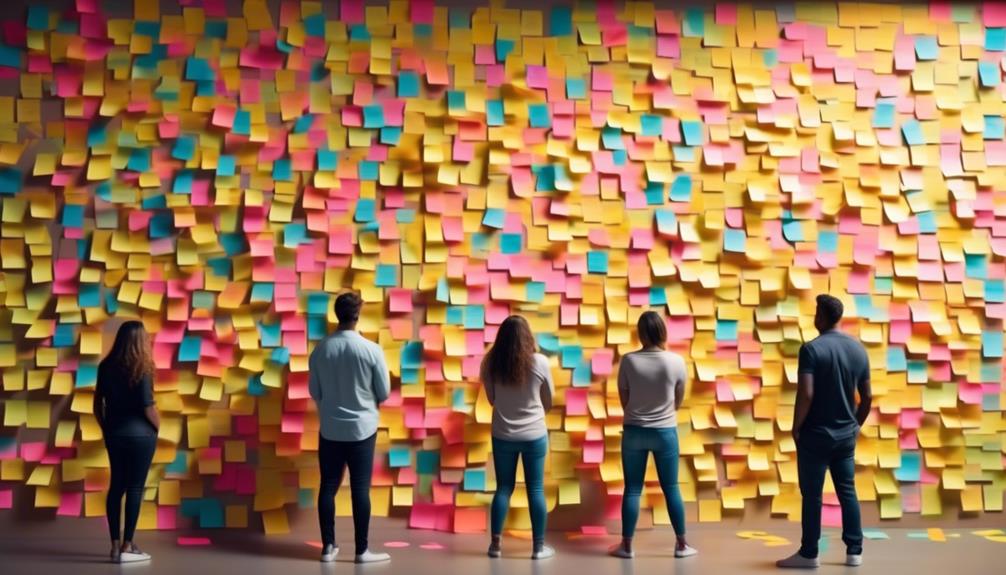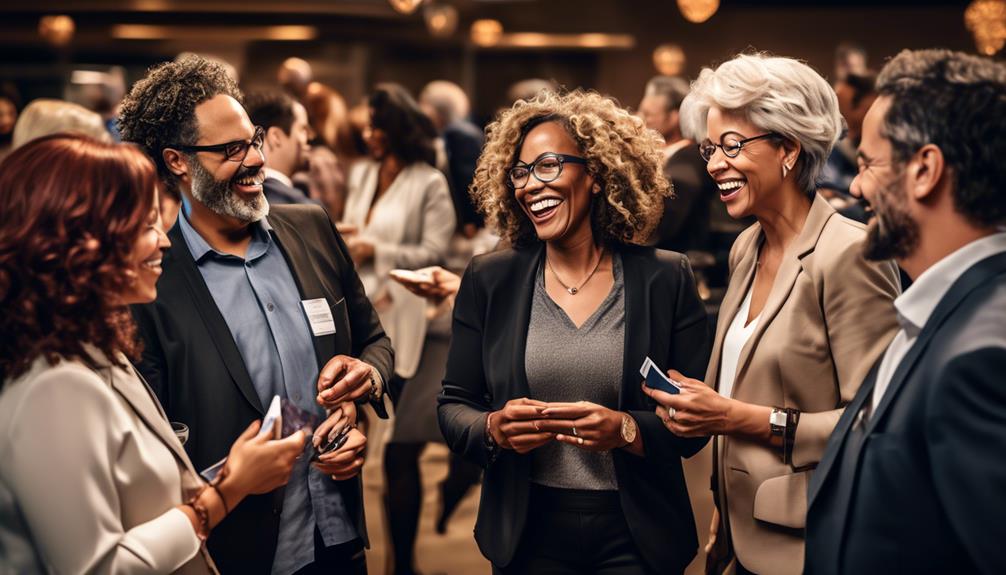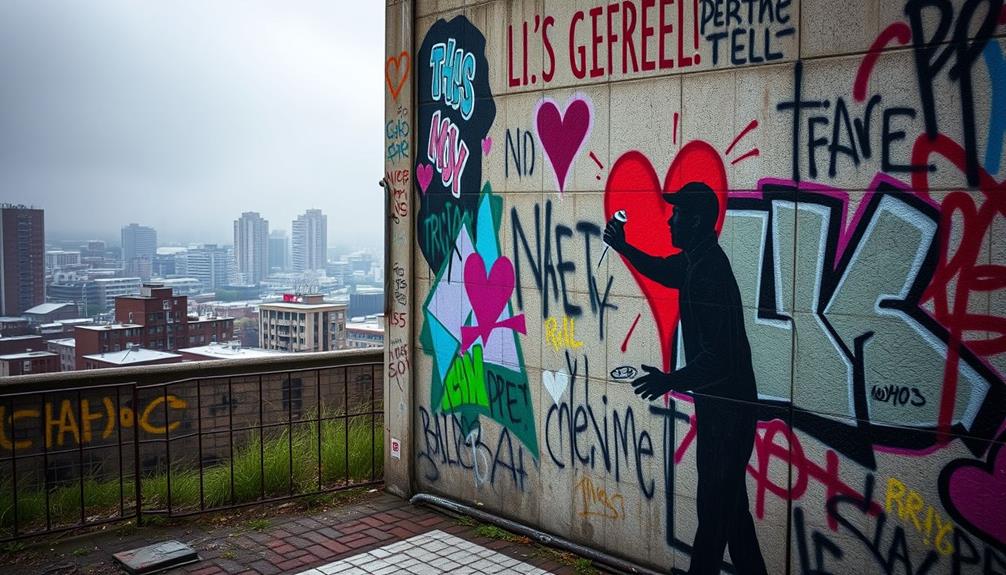As a team, we have all faced the challenge of setting goals that tend to get forgotten as the year goes on. It is common for teams to struggle to align with the company’s objectives and maintain focus on reaching them.
However, there are proven team building activities that can not only help us set clear and achievable goals but also strengthen our collaboration and communication. These activities are designed to foster a sense of purpose, accountability, and motivation among team members, ultimately leading to a more productive and cohesive work environment.
Key Takeaways
- Harness the power of visualization and creativity to create a visual representation of collective aspirations
- Break down goals into smaller steps and establish SMART project goals for clarity and accountability
- Ensure goals are specific, measurable, achievable, relevant, and time-bound to promote success
- Track progress, evaluate achievements, and make necessary adjustments to stay motivated and focused on targets
Vision Boarding
We enthusiastically engage in vision boarding as a dynamic and creative tool for visualizing and articulating our team goals.
Vision boarding allows us to harness the power of visualization and creativity to bring our goals to life. By creating a visual representation of our collective aspirations using images and quotes, we tap into our team's creative energies and foster a sense of involvement and excitement.
Whether we choose to use physical boards or digital platforms, the process of vision boarding encourages active participation from all team members, making goal setting a collaborative and engaging experience.
As we curate our vision boards, we gain a fresh perspective on our goals, igniting a renewed sense of purpose and motivation within the team. This activity not only aligns our individual visions but also strengthens our bond as a team, fostering a shared commitment to achieving our goals.
Vision boarding is a powerful team-building exercise that enables us to see our goals from a new angle, driving us towards success with a unified purpose.
Backward Goal Setting

Embracing the concept of working backwards from our ultimate vision, we employ backward goal setting as a strategic approach to crafting clear and actionable objectives for our team. By starting with the end goal and breaking it down into smaller, achievable steps, we ensure that our team is aligned and focused on the path to success. This method allows us to establish SMART project goals, ensuring that our objectives are Specific, Measurable, Achievable, Relevant, and Time-bound.
| Rational Reasons | Emotional Reasons | Steps to Achieve |
|---|---|---|
| Clarity on the desired outcomes | Inspiration and motivation | Identify key milestones |
| Understanding the specific actions required | Team morale and engagement | Assign responsibilities |
| Focused direction towards success | Team unity and camaraderie | Regular progress tracking |
Backward goal setting encourages our team to visualize and understand what success looks like, and then work together to outline the necessary steps to achieve it. This approach not only fosters a sense of purpose and direction but also promotes collaboration and accountability within the team.
SMART Goal Setting
When setting goals, it's crucial to make them specific, measurable, achievable, relevant, and time-bound.
We need to ensure that our goals are clearly defined and can be tracked and evaluated as we make progress.
It's important to set realistic and attainable goals that align with our overall objectives and have a specific time frame for completion.
Specific Goals Importance
Fostering a culture of specific goal setting is essential for providing clear direction and focus for individuals and teams. When setting specific goals, it's crucial to involve the team in the process; this promotes buy-in, commitment, and shared ownership.
Effective team goal setting involves creating measurable goals that contribute to the overall objectives, ensuring that progress can be tracked and celebrated. Incorporating SMART goals (Specific, Measurable, Achievable, Relevant, Time-bound) helps ensure clarity, accountability, and relevance in goal setting.
Measurable Progress Tracking
We prioritize measurable progress tracking by implementing SMART goal setting, ensuring clear and tangible objectives for our team's success.
Through team goal-setting activities, we emphasize the importance of setting specific, measurable, achievable, relevant, and time-bound (SMART) goals.
Visual representation plays a crucial role in this process, allowing us to track our progress and stay focused on our targets.
By engaging in this goal setting activity, we can work toward our objectives with a results-oriented mindset.
Measurable progress tracking enables us to evaluate our achievements, make necessary adjustments, and stay motivated as we strive to achieve greater success.
This method fosters clarity, direction, and accountability, empowering us to monitor our advancement effectively and stay on course towards our goals.
Attainable Goal Setting
Tracking our measurable progress through SMART goal setting has paved the way for us to focus on setting attainable and realistic objectives for our team's success.
When it comes to attainable goal setting, we prioritize activities that foster a sense of personal growth and accomplishment, as individuals work together to achieve realistic objectives.
We actively engage in team building activities that promote a strong sense of purpose and achievement, aligning our efforts with SMART goal criteria to ensure that our goals are challenging yet realistic.
Accountability Partnerships

Team members can leverage accountability partnerships to support each other in achieving their goals by regularly discussing progress, setbacks, and challenges. These partnerships are a powerful tool for promoting employee engagement and fostering a culture of goal setting within a team.
By working together in accountability partnerships, individuals can provide each other with encouragement, feedback, and support, creating a sense of shared responsibility for achieving their objectives.
When team members set goals and work towards them in collaboration with an accountability partner, they're more likely to stay motivated and committed to their objectives. These partnerships not only facilitate progress towards individual goals but also contribute to the overall success of the team. By regularly checking in with their accountability partner, employees can maintain focus, stay on track, and overcome obstacles more effectively.
Incorporating accountability partnerships into team building activities can cultivate a sense of camaraderie and shared achievement. As individuals hold each other accountable, they foster an environment where everyone is committed to personal and collective success. This approach not only enhances goal achievement but also strengthens teamwork and collaboration within the organization.
Defining Success

Incorporating accountability partnerships into team building activities can cultivate a sense of camaraderie and shared achievement, which is essential when defining success within a team.
When defining success, it's crucial to set clear and measurable goals that align with the organization's vision and values. This ensures that everyone is working towards a common purpose and understanding the desired outcomes.
Success should encompass both quantitative and qualitative achievements, including personal growth, team collaboration, and overall impact. It's important to communicate and align team members on what success means for the team and the organization as a whole, emphasizing the multifaceted nature of success.
Additionally, defining success requires regularly revisiting and adapting the definition as the team and organization evolve, acknowledging that success is dynamic.
Rapid Ideation

Let's explore how rapid ideation can enhance our brainstorming techniques. By embracing quantity over quality, we can unleash a diverse range of potential solutions and break through mental blocks. This approach encourages active participation and a non-judgmental environment, allowing for the free flow of creative ideas.
Fostering creative problem-solving and inspiring innovative idea generation methods are also benefits of rapid ideation. With a focus on generating a large number of ideas quickly, we can explore different perspectives and approaches to solving problems. This helps us think outside the box and come up with unique and innovative solutions.
Brainstorming Techniques
To encourage rapid ideation during brainstorming sessions, set a specific time limit to spur quick thinking and idea generation. Time constraints prompt members to think on their feet, fostering effective brainstorming techniques.
Emphasize quantity over quality to inspire a high volume of ideas within the allotted time. This approach encourages the team to work together, generating a diverse range of thoughts and perspectives.
Effective brainstorming techniques in team building activities for goal setting involve building on ideas to foster collaborative thinking. By incorporating diverse members and encouraging rapid idea generation, teams can harness the power of collective creativity to achieve their goals.
Creative Problem Solving
Rapid Ideation, a creative problem-solving technique, encourages teams to generate a large volume of ideas within a specific time limit, fostering quick thinking and innovative solutions. This method, often used in goal setting activities and team building, is a powerful tool for tackling complex challenges.
By conducting rapid ideation sessions, teams can break through mental blocks and explore unconventional solutions to problems. It fosters creativity and innovation by allowing participants to generate a multitude of ideas in a short period.
Rapid ideation is an effective way to drive forward-thinking solutions and can be particularly beneficial in goal setting games and brainstorming sessions aimed at achieving professional goals. It enables teams to tap into their collective creativity and find fresh perspectives on difficult issues.
Idea Generation Methods
After creatively tackling complex challenges in goal setting activities and team building through rapid ideation, we can now explore effective idea generation methods for fostering innovation and problem-solving.
Rapid Ideation is a powerful tool for generating a plethora of ideas within a constrained time frame. It encourages quick thinking and creativity, enabling teams to make significant strides in planning success. This method works seamlessly in both individual and group settings, leveraging diverse perspectives to produce innovative solutions.
By employing rapid ideation, teams can work collaboratively to refine and explore a large pool of ideas, setting the stage for successful goal setting activities and problem-solving initiatives.
- Rapid Ideation fosters quick thinking and creativity, leading to innovative solutions.
- It allows teams to leverage diverse perspectives for idea generation, enhancing the quality of outcomes.
- The method enables efficient exploration and refinement of a large pool of ideas, laying the groundwork for planning success.
Setting Specific Milestones

Individually identifying specific milestones within a larger goal is essential for effective team goal setting and achievement. Setting specific milestones involves breaking down larger objectives into smaller, manageable targets. These milestones provide clear markers for progress and achievement, helping to align team efforts and keep everyone focused on the larger goal. By incorporating specific milestones into the action plan, employees are able to track their progress and adjust their strategies as needed.
Achieving these milestones provides a sense of accomplishment and motivation, driving the team towards the ultimate goal.
To implement this within team building activities, consider creating exercises where employees work together to identify and set specific milestones for a given goal. This can involve brainstorming sessions, collaborative discussions, and task allocation to ensure that each milestone is attainable and contributes to the larger objective.
Additionally, regular check-ins and progress evaluations can be integrated into these activities to keep the team accountable and motivated. By emphasizing the importance of setting and reaching specific milestones, team building activities can significantly enhance goal setting and achievement within the workplace.
Reverse Planning

Let's start by exploring goal visualization techniques, which are essential for reverse planning.
Effective timeline management is crucial for ensuring that our reverse planning process stays on track.
Lastly, we'll look at team collaboration strategies that can help us implement reverse planning effectively and achieve our goals.
Goal Visualization Techniques
To effectively achieve our goals, utilizing reverse planning, a technique involving working backward from the end goal to identify smaller, intermediate goals, is essential for providing a clear roadmap and ensuring team alignment.
When employing goal visualization techniques such as reverse planning, it's crucial to:
- Foster Clarity: Visualizing the end goal and breaking it down into smaller, achievable milestones provides a clear roadmap for the team, enhancing understanding and focus.
- Encourage Commitment: Involving team members in the reverse planning process fosters buy-in, commitment, and shared responsibility for achieving the end goal, boosting motivation and dedication.
- Ensure Alignment: Setting specific and time-bound milestones through reverse planning helps in tracking progress, ensuring team alignment, and fostering a sense of achievement.
Effective Timeline Management
After visualizing our end goal and breaking it down into achievable milestones with reverse planning, effective timeline management becomes crucial for guiding our actions toward successful goal attainment.
Utilizing this strategy involves working backward from the end goal to identify smaller, intermediate goals, ensuring that each action contributes to the overall success of the organization.
Reverse planning not only helps achieve the end goal but also provides markers to track progress and motivates the team through the satisfaction of achieving smaller milestones. It's a valuable tool for aligning efforts and contributing to overall success, providing a sense of achievement, progress, and clarity within the team.
Involving team members in the reverse planning process ensures buy-in, commitment, and shared responsibility, fostering a sense of ownership and enhancing team engagement.
Effective timeline management is essential for team building, individual projects, and coming up with new goal setting tools and resources.
Team Collaboration Strategies
Team collaboration strategies, particularly reverse planning, play a critical role in achieving our goals effectively and efficiently.
When implementing reverse planning, we focus on breaking down our ultimate goal into smaller, manageable milestones. This approach allows us to create a clear and detailed roadmap, ensuring that every action contributes to the larger goal.
Additionally, involving our team in the planning process fosters commitment, engagement, and a shared sense of responsibility.
By prioritizing critical goals that align with our vision, we ensure efficient resource allocation and maintain our team's focus.
This collaborative approach leverages our employees' strengths and mitigates weaknesses, ultimately leading to a more cohesive and effective team.
Setting Legacy

Defining the impact and values we aim to leave behind, setting legacy involves creating a meaningful and lasting contribution. It goes beyond short-term goals, focusing on the enduring imprint we want to make. When it comes to team goal setting activities, considering legacy can significantly enhance the depth and purpose of our objectives. By integrating the concept of legacy into our goal setting process, we build a team that is not only effective in achieving immediate targets but also mindful of the long-term implications of their actions.
Here's a table to showcase the impact of legacy in goal setting:
| Legacy Impact | Emotional Resonance | Purposeful Action |
|---|---|---|
| Inspires a sense of responsibility | Evokes passion and commitment | Drives strategic and sustainable decisions |
| Aligns personal and team goals with broader values | Fosters a deep sense of fulfillment | Encourages proactive and ethical behavior |
| Promotes accountability towards leaving a positive legacy | Cultivates a strong sense of pride | Sparks innovation and creativity |
Team SWOT Analysis

Considering the impact of legacy in our goal setting process, we now turn our attention to conducting a Team SWOT Analysis to enhance our team's strategic planning.
Team SWOT Analysis is a powerful tool that allows us to gain a comprehensive understanding of our team's internal dynamics and external environment. Here's why Team SWOT Analysis is crucial for effective goal setting:
- Strategic Alignment: By identifying our strengths and weaknesses, we can align our team's goals with the company's objectives, ensuring that our efforts contribute to the overall success of the organization.
- Enhanced Employee Retention: Understanding the opportunities and threats facing our team enables us to create an environment that fosters growth and development, leading to higher employee satisfaction and retention.
- Informed Decision Making: The insights gained from the analysis empower us to make informed decisions, allowing us to capitalize on opportunities and proactively address potential threats to achieve our company goals.
Frequently Asked Questions
How Do You Make Goal-Setting Fun at Work?
We make goal-setting fun at work by infusing interactive exercises, team-based activities, and creative techniques. We foster transparency with live TV dashboards and use incentives to motivate and enhance goal achievement.
What Are the Goal-Setting Icebreaker Activities?
Goal-setting icebreaker activities foster collaboration, creativity, and engagement while aligning team goals. Using games and visual tools, these activities encourage strategic thinking and build a strong foundation for shared objectives.
How Do You Facilitate Team Goal-Setting?
We facilitate team goal-setting by engaging in structured exercises and backward goal setting to break down objectives. Our team-building activities like 'Ball in the Air' and 'The Ideal Day' promote collaboration, understanding, and shared achievement.
What Are Goal Oriented Training Activities?
We engage in goal-oriented training activities to set clear and measurable objectives, foster collaboration, and enhance creativity. We utilize interactive games like 'Ball in the Air' and 'The Ideal Day' to promote teamwork and achieve our goals.
Conclusion
In conclusion, team building activities for goal setting are essential for fostering a collaborative and aligned team.
Did you know that teams who engage in regular goal setting activities are 17% more likely to achieve their goals?
By implementing these activities, teams can enhance their communication, accountability, and overall success in reaching their objectives.
So, why not give these activities a try and see the positive impact on your team's performance?
Joy, as our Editor in Chief, ensures the highest standard of content. Her talent in writing is complemented by her attention to detail and passion for literature and culture. Joy’s expertise and love for the English language shine through in her editorial work, making each piece a testament to quality and clarity.










